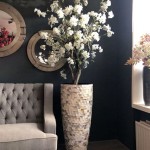```html
New Mexican Home Decor: A Guide to Authentic Southwest Style
New Mexican home decor represents a distinct and evocative aesthetic deeply rooted in the region's rich history and diverse cultural influences. This style, characterized by a blend of Native American, Spanish, and Anglo traditions, creates warm, inviting, and visually captivating spaces. Incorporating New Mexican elements into home decor involves understanding its key characteristics and how they can be applied to create a cohesive and authentic look.
The foundation of New Mexican style lies in its connection to the natural environment. The arid landscape, abundant sunlight, and locally sourced materials play a crucial role in shaping the color palettes, textures, and overall design principles. Earth tones, such as terracotta, sand, and ochre, dominate the color scheme, reflecting the hues of the desert landscape. These are often accented by vibrant pops of turquoise, red, and yellow, inspired by Native American textiles and crafts.
Materials commonly used in New Mexican decor include adobe, wood, and metal. Adobe, a traditional building material made from sun-dried earth and straw, provides a sense of warmth and rustic charm. Wood, often in the form of exposed beams, carved furniture, and handcrafted details, adds texture and visual interest. Metal, particularly wrought iron and tin, is used for decorative accents, lighting fixtures, and functional hardware. Together, these materials contribute to the overall sense of authenticity and handcrafted quality that defines New Mexican style.
Color Palette and Natural Light
The color palette is arguably the most defining characteristic of New Mexican home decor. It's not merely about choosing specific colors but understanding how they interact with natural light, a crucial element in Southwestern design. Earth tones, as previously mentioned, form the base. These neutral shades create a sense of calm and allow other elements in the room to stand out. The intensity of the New Mexican sun necessitates careful consideration of color saturation. Colors that appear vibrant indoors can become overwhelming under direct sunlight. Therefore, muted and slightly desaturated versions of brighter colors are often preferred.
Turquoise, a color of significant cultural importance to Native American tribes, is frequently used as an accent color. It can be incorporated through artwork, pottery, textiles, and even painted window frames or door trim. Red, often found in chile ristras (strings of dried red chiles) and traditional blankets, adds warmth and energy to the space. Yellow, reminiscent of the desert sunsets, can be used sparingly to create highlights and visual interest.
Natural light plays a vital role in enhancing these colors and creating a welcoming atmosphere. Large windows, often facing south to maximize sunlight exposure, are a common feature in New Mexican homes. However, managing the intensity of the light is equally important. Woven shades, wooden shutters, or light-filtering curtains can help to control the amount of sunlight entering the room, preventing glare and fading of furniture and artwork.
The use of white is also significant, often employed for walls to reflect light and create a sense of spaciousness. Distressed or textured white walls contribute to the rustic aesthetic, while smooth white walls offer a more contemporary and minimalist take on New Mexican style.
Furniture and Decorative Elements
Furniture in New Mexican homes typically emphasizes handcrafted quality and rustic appeal. Heavy, solid wood pieces are common, often adorned with carved details and distressed finishes. These pieces are designed to be durable and functional, reflecting the practicality of the region's early settlers. Think of heavy wooden dining tables, sturdy benches, and hand-carved chests.
Another prominent furniture style is the use of painted furniture sometimes referred to as "Santa Fe Style." These pieces often feature vibrant colors and decorative paintings, drawing inspiration from Spanish Colonial artwork. The motifs can range from simple geometric patterns to elaborate floral designs, adding a touch of whimsy and personality to the space.
Rugs and textiles play a crucial role in adding warmth, texture, and cultural significance to New Mexican decor. Navajo rugs, with their intricate geometric patterns and earthy colors, are highly valued for their craftsmanship and artistic merit. These rugs can be used as floor coverings, wall hangings, or even draped over furniture as decorative accents.
Other popular textiles include serapes, blankets woven from wool or cotton, and decorative pillows featuring traditional Southwestern motifs. These textiles can be used to add pops of color and visual interest to sofas, chairs, and beds. The use of natural fibers, such as wool, cotton, and linen, further enhances the sense of authenticity and connection to the natural environment.
Pottery is another essential element of New Mexican home decor. Native American pottery, particularly from tribes like the Pueblo and Navajo, is highly sought after for its unique designs and handcrafted quality. Common pottery forms include ollas (large storage jars), bowls, and vases, often decorated with geometric patterns, animal motifs, or depictions of scenes from daily life.
Other decorative elements that are commonly incorporated into New Mexican homes include:
- Santos: Hand-carved religious figures, often depicting saints or other spiritual figures.
- Ristras: Strings of dried red chiles, traditionally hung as a symbol of good luck and prosperity.
- Wrought Iron Accents: Used for lighting fixtures, fireplace screens, and decorative hardware.
- Tinwork: Embossed and painted tin panels, used for decorative accents and picture frames.
- Artwork: Paintings, sculptures, and prints featuring Southwestern landscapes, Native American subjects, and scenes from New Mexican history.
Architectural Details and Lighting
The architectural details of a New Mexican home contribute significantly to its overall aesthetic. Thick adobe walls, exposed wooden beams, and kiva fireplaces are all characteristic features of this style. These elements create a sense of warmth, intimacy, and connection to the past.
Kiva fireplaces, inspired by the ceremonial chambers of Pueblo Native Americans, are unique to the Southwest. These fireplaces are typically round or square in shape and are often built into the corner of a room. They are known for their efficient heating and their distinctive appearance.
Vigas, or exposed wooden beams, are another common architectural feature. These beams are typically made from pine or cedar and are left exposed to showcase the natural beauty of the wood. Vigas can be stained or painted to complement the overall color scheme of the room.
Flooring options in New Mexican homes often include terracotta tiles, wood planks, or concrete. Terracotta tiles, with their warm earthy tones and textured surface, are a classic choice. Wood planks, particularly those with a distressed or aged finish, add to the rustic charm of the space. Concrete floors, which can be stained or polished, offer a more contemporary and minimalist option.
Lighting plays a crucial role in creating the right ambiance in a New Mexican home. The goal is to create a warm, inviting, and layered lighting scheme that complements the natural light. Recessed lighting can be used to provide general illumination, while accent lighting can be used to highlight artwork, architectural details, and decorative elements.
Wrought iron chandeliers and sconces, with their rustic appeal and intricate designs, are a popular choice for lighting fixtures. Table lamps with woven shades or pottery bases can add a touch of warmth and texture. The use of dimmer switches is also recommended to allow for greater control over the lighting levels.
Candles are frequently used for their soft, flickering light and their ability to create a sense of intimacy. Candles can be placed in decorative candle holders or lanterns to add to the overall aesthetic.
By carefully considering the architectural details and lighting options, it is possible to create a New Mexican home that is both beautiful and functional, reflecting the unique character and charm of the Southwest.
```
The Local Flea

Warm And Casual Southwest Style Is Hot In Décor Santa Fe New Mexican Home Real Estate Santafenewmexican Com

A Home Inspired By New Mexico History Mountain Living

28 Stunning New Mexican Decor Ideas You Can Totally Copy Adobe Home House

Spice Up A Home With Mexican Interior Décor Moving Service Ny

The Local Flea

How To Decorate Your Home With Vibrant Mexican Flair

Home Decor San Diego Kitchen Renovation Bazaar Del Mundo

20 Marvelous Mexican Living Rooms Home Design Lover Interior Interiors

Starr Interiors Fine Weavings Taos Nm Designer Rugs Furnishings Since 1974 Hand Loomed To Last A Lifetime
Related Posts







